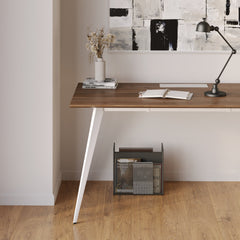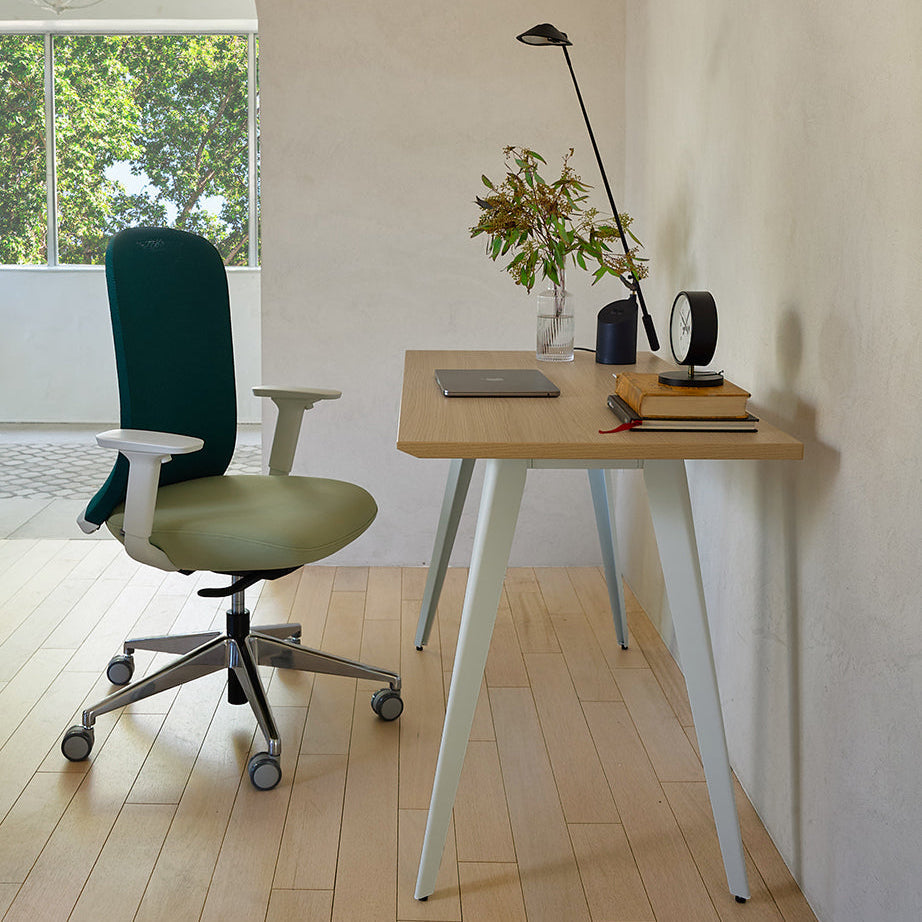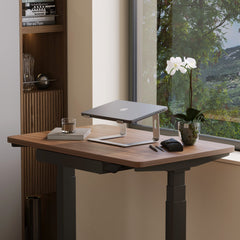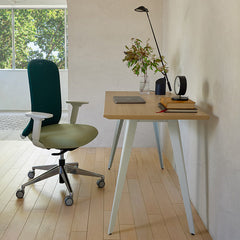Get 10% off your first order
Find the office furniture that’s designed to match your style, comfort, and needs perfectly. Subscribe
Boundary Work From Home Setup: How to Define Your Home Office Zone

Visit quiz page to see how we makes it easy to create an inspiring workplace


The right workspace blends inspiration with calm, and few materials do this better than wood. Its texture, tone, and natural grain create warmth that synthetic materials rarely match. As remote work reshapes how we spend our days, wood’s grounding energy reminds us of rhythm, balance, and focus.
Let’s explore how natural wood tones can transform your home office into a space that feels intentional, soothing, and alive.
We respond emotionally to natural textures. The warmth of wood softens modern spaces and brings a tactile reminder of nature’s balance.
Reduces visual fatigue.
Enhances comfort and relaxation.
Adds texture and depth to minimalist layouts.
Improves mood and connection to surroundings.
Wood connects productivity with peace, grounding the energy of remote work.
Different wood tones influence how your workspace feels. The Small Standing Desk Kentucky blends rich texture with adaptability—perfect for balancing warmth and utility.
|
Tone |
Feel |
Ideal Use |
|
Light Oak |
Airy and open |
Small or bright rooms |
|
Warm Walnut |
Cozy and inviting |
All-day use workspaces |
|
Ash |
Neutral and modern |
Balanced minimalist designs |
|
Deep Mahogany |
Classic and rich |
Traditional or study spaces |
Each tone tells a different story—choose the one that complements your rhythm and style.
Wood reacts beautifully to light. Natural sunlight brings out golden undertones, while warmer artificial lighting enhances depth and texture.
Place your desk near a natural light source.
Use warm-toned lamps for cozy evenings.
Avoid harsh overhead lighting that flattens color.
Mix direct and ambient light to reveal the grain’s details.
Lighting brings your wood surfaces to life—like sunlight through forest leaves.
Wood pairs effortlessly with metal, glass, or matte finishes, striking balance between warmth and modernity.
A standing desk with clean lines complements the softness of wood, giving your workspace a grounded yet contemporary aesthetic.
|
Material Pairing |
Effect |
Mood |
|
Wood + Metal |
Balanced contrast |
Structured focus |
|
Wood + Fabric |
Soft texture mix |
Cozy productivity |
|
Wood + Glass |
Open brightness |
Light, modern style |
|
Wood + Stone |
Earthy connection |
Natural calm |
Contrast brings balance, just as work needs both structure and softness.
Minimalist design can sometimes feel cold, but wood tones bring natural warmth that balances simplicity with comfort.
Keep surfaces clear, highlighting the wood grain.
Use neutral décor to complement the natural tones.
Let one wooden element anchor the space.
Avoid glossy finishes that overpower texture.
Minimalism feels more inviting when paired with natural warmth.
Comfort completes beauty. A modern office desk merges ergonomic precision with timeless craftsmanship. The goal is to feel supported—not confined.
|
Element |
Focus |
Benefit |
|
Adjustable height |
Posture support |
Reduces strain |
|
Rounded edges |
Safety |
Soft visual flow |
|
Natural surface finish |
Texture |
Tactile comfort |
|
Spacious layout |
Function |
Easy movement |
A workspace should feel like an extension of your body—functional yet organic.
Research shows that natural materials can reduce stress and improve cognitive performance. Wood tones lower tension, increase relaxation, and help sustain focus over longer periods.
Keep plants nearby to complement natural textures.
Use warm-toned backgrounds for digital meetings.
Diffuse soft light to maintain calm energy.
Limit harsh contrasts between furniture colors.
A workspace that feels natural also feels sustainable—mentally and physically.
The comfort of home can blur boundaries between work and rest. According to remote work studies, comfort-driven environments improve long-term motivation. Wood tones help maintain this balance by introducing texture that feels personal and grounding.
Choose natural materials for tactile calm.
Avoid overly polished or artificial finishes.
Keep lighting consistent with your workspace tone.
Balance technology with texture—warm wood against cool metal or glass.
A comfortable environment fuels consistency and reduces burnout.

Natural wood pairs beautifully with modern ergonomic accessories that enhance your workflow without clutter. A supportive ergonomic arm accessory complements the fluid movement of wooden surfaces.
|
Accessory |
Placement |
Effect |
|
Ergonomic armrest |
Edge of table |
Reduces wrist tension |
|
Laptop riser |
Center alignment |
Maintains eye level |
|
Hidden cable channels |
Below surface |
Keeps clarity |
|
Small lighting fixture |
Side of desk |
Adds warmth |
Technology meets nature best when design remains invisible but intentional.
Wood’s charm grows with time, but maintenance preserves its natural warmth.
Dust weekly with a dry, soft cloth.
Use coasters to avoid water rings.
Apply natural oil or wax seasonally.
Keep surfaces away from direct heat or sunlight.
Good care turns furniture into a lasting companion, not just a surface for work.
The closer your workspace feels to nature, the more balanced your workday becomes. Adding plants, textured fabrics, and organic shapes enhances the grounding power of wood.
Use greenery near wood elements for harmony.
Keep windows open for natural airflow.
Choose soft, earthy accent tones.
Let sunlight define your workspace mood.
Wood connects your workday to the quiet rhythm of the outdoors.
Wood tones become even warmer when paired with the right textures. Natural fibers and fabrics add softness to the workspace, balancing the structure of wood with comfort.
|
Material |
Effect |
Best Use |
|
Linen |
Light and breathable |
Curtains, table runners |
|
Wool |
Cozy and grounding |
Chair cushions |
|
Cotton canvas |
Clean and structured |
Desk organizers |
|
Rattan |
Airy and organic |
Accent furniture |
Mixing textures creates a sensory balance—smooth surfaces meet soft finishes for a workspace that feels lived-in, not staged.
Even the richest wood tones lose their effect if your space feels cramped. How furniture interacts with light, air, and walking space affects how warmth is experienced.
Keep your table near natural light to bring out grain details.
Leave clear pathways to make the space breathable.
Balance heavy wooden pieces with lighter materials.
Position your chair and desk to face an open area.
A layout that flows well makes wood tones feel natural, not heavy—and that helps maintain focus through long work hours.
Not everyone has a separate home office. In multifunctional rooms, wood tones help define your work zone without disrupting the home’s overall style.
Use light-toned furniture to keep the room open.
Add a small quad workstation for dual setups that still feel cohesive.
Choose consistent finishes across the room.
Use floor rugs or plants to create subtle workspace boundaries.
Wood’s warmth makes transitions between work and home smooth, especially in compact or shared living environments.

The appeal of natural wood isn’t just aesthetic—it’s emotional. It reminds us that calm and focus can exist in the same space. By choosing warm, tactile materials, you create an environment that feels authentic and restorative, even on the busiest days.
Surround yourself with warmth, not excess.
Design your space for stillness and rhythm.
Let texture guide creativity.
Keep your workspace simple, natural, and alive.
In a world of screens and fast shifts, the quiet honesty of wood offers something rare—balance.

Boundary Work From Home Setup: How to Define Your Home Office Zone

Hidden Hazards: 5 Ergonomic Traps Derailing Your Remote Work

Decoding Deep Work: The Neuroscience of Your Desktop
Get 10% off your first order
Find the office furniture that’s designed to match your style, comfort, and needs perfectly. Subscribe
Leave a comment